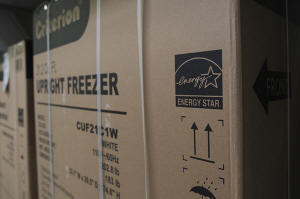Energy Star, efficiency program that has steered consumer choice,
targeted in cuts
[May 08, 2025] By
MICHAEL PHILLIS and ALEXA ST. JOHN
An Environmental Protection Agency plan to eliminate its Energy Star
offices would end a decades-old program that gave consumers a choice to
buy environmentally friendly refrigerators, dishwashers and other
electronics and save money on electric bills, consumer and environmental
groups said.
The changes, outlined in agency documents reviewed by The Associated
Press, are part of a broad reorganization at the EPA that would
eliminate or reorganize significant parts of the office focused on air
pollution. Those plans advance President Donald Trump's sharp turn away
from the prior administration's focus on climate change.
The EPA did not confirm directly it was ending the program, first
reported Tuesday by CNN, but said the reorganization “is delivering
organizational improvements to the personnel structure that will
directly benefit the American people and better advance the agency’s
core mission, while Powering the Great American Comeback.”
The EPA launched Energy Star in 1992 with the goal of tackling
environmental protection and economic growth. It boosts the market for
energy-efficient products and benefits companies that design appliances
that earn the label. A home that decides to buy Energy Star products can
save $450 annually on energy costs, the program's website says.
“People recognize it right away, so they would be like ‘oh, it is Energy
Star, so I should probably go with this one,’” said Francis Dietz,
spokesperson with the trade association Air-Conditioning, Heating, and
Refrigeration Institute.

Steven Nadel, executive director of the American Council for an
Energy-Efficient Economy, said the program enjoyed bipartisan support
until recently. It promotes efficiency by tightening standards when lots
of products are able to meet the label requirements, he said.
Big savings in money and pollution
Since its start, the program has reduced energy costs by more than $500
billion and prevented about 4 billion metric tons of planet-warming
greenhouse gas emissions, according to its website. Appliances can be
responsible for tons of air pollution, but efficiency measures can
reduce the carbon dioxide, methane, sulfur dioxide, nitrogen oxide and
fine particulate matter that producing the electricity releases into the
atmosphere. These pollutants can harm the heart and lungs, and cause
other health issues.
Trump's proposed budget asks that Congress eliminate the EPA's entire
Atmospheric Protection Program, which houses the offices that run Energy
Star. The budget described the program as “an overreach of Government
authority that imposes unnecessary and radical climate change
regulations on businesses and stifles economic growth.”
But Sarah Gleeson, climate solutions research manager at the climate
action nonprofit Project Drawdown, said America’s energy independence
depends on the ability to meet U.S. energy demands, and cutting the
program imperils that and strains households at the same time.
[to top of second column] |

An Energy Star logo is displayed on a box for a freezer Jan. 21,
2025, in Evendale, Ohio. (AP Photo/Joshua A. Bickel, File)
 Gleeson said losing Energy Star will
make it harder for consumers to have trustworthy information about
products' energy use.
Label is voluntary, and Congress ordered it
The Energy Star label is voluntary for products that meet certain
efficiency levels, and differs from Department of Energy standards
that set minimum efficiency requirements that products must meet to
be legally sold. In the 2000s, Congress directed the EPA and
Department of Energy to run an energy-efficiency program and promote
Energy Star.
The DOE did not comment on the changes and its role moving forward,
deferring questions to the EPA. According to the program's website,
DOE's role includes developing product testing procedures. The EPA
is responsible for setting performance levels and ensuring consumers
can rely on the label.
The Association of Home Appliance Manufacturers said it supports a
streamlined Energy Star program through the DOE. Spokeswoman Jill
Notini said that “would meet the administration’s goals of
preserving a full selection of products from which consumers can
choose, and reducing unnecessary regulatory burden.”
The move is the latest in the Trump administration's broader
deregulatory effort. They've announced plans to slash Biden-era
policies to reduce greenhouse gas emissions and prioritized fossil
fuels and an energy-dominance policy.
The president has been particularly keen on eliminating efficiency
standards, arguing they result in products that cost more and are
less effective, and that they deny consumer choice. Trump has
reversed rules restricting water flow for showerheads and other
household appliances.
Trump targeted Energy Star during his first stint in the White
House, but faced backlash.

“For an administration who keeps claiming the country is facing an
‘energy emergency,’ Trump continues to attack any and all efforts
aimed at saving energy through efficiency," Xavier Boatright, deputy
legislative director for clean energy and electrification at Sierra
Club said in a statement. “When we waste energy through inefficient
appliances the fossil fuel industry uses it as an excuse to extract
and sell more of its product to make more money on the backs of the
American people.”
All contents © copyright 2025 Associated Press. All rights reserved |